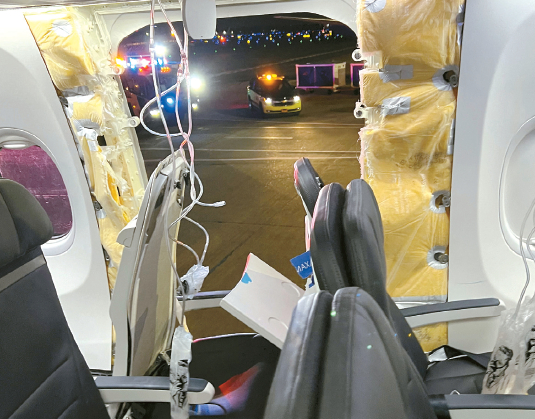
By Hoonsik Woo
The author is a local news reporter for the Korea Daily.
When booking a plane ticket, now there’s one more thing to check besides the price and date, and that’s the aircraft type.
On January 5, Alaska Airlines Flight 1282, which was operating Boeing’s 737 Max 9 airliner, took off from Portland International Airport in Oregon around 5:00 p.m. but made an emergency landing back to the airport just 20 minutes after departure. It is because a portion of the airliner’s fuselage (door plug) was ripped off at about 16,000 feet up in the air at the time. Fortunately, the plane, carrying 171 passengers and six crew members, landed safely, with only a few passengers suffering minor injuries.
The Federal Aviation Administration (FAA) immediately grounded all airplanes of same kind and ordered an extensive inspection. Alaska Airlines and United Airlines, which operate the Max 9, canceled all scheduled flights to follow FAA’s order. After the inspection, Alaska Airlines resumed flying the Max 9 on January 26, three weeks after the incident, with United Airlines starting later on January 28, but passengers’ fears have not yet gone away.
But who is to blame? It is hard to say it is the airline’s fault but it is rather believed to be the manufacturer’s. The Wall Street Journal, citing industry experts, reported that missing key screws were likely the cause of the incident, explaining that the door plugs showed no signs of being bolted together. This raises questions about Boeing’s oversight of the manufacturing process.
Boeing is a major U.S. airliner manufacturer, and the 737 Max 9 is one of the company’s newest line of models. It is no wonder that airline passengers are frustrated with riding Boeing’s.
On January 10, Dave Calhoun, CEO of Boeing, acknowledged responsibility for the incident with Alaska Airlines, saying “we caused the problem.” In the aftermath, Boeing’s stock price plummeted more than 18% in the three weeks following the incident, which is about $28 billion of company net worth evaporating. But that’s only part of the blame for what could have easily claimed more than 170 lives. Nine passengers of Alaska Airlines are suing Boeing for physical injuries and emotional distress, and Boeing shareholders have also filed a class action lawsuit alleging the company’s poor airliner quality supervision and inflated stock prices accordingly.

Ben Minicucci, CEO of Alaska Airlines, told NBC on January 23 that “I’m more than frustrated and disappointed, I am angry” about the flight manufacturing company, adding “It happened to Alaska Airlines, to our guests, and to our people. My demand on Boeing is what are they going to do to improve their quality.”
Previously, Boeing’s aircraft were involved in two crashes of Indonesian Lion Air Flight 610 in October 2018 and Ethiopian Airlines Flight 302 in March 2019. The crashes killed a total of 346 people on board of the two airliners. At the time, Boeing reportedly concealed a flaw in its Maneuvering Characteristics Augmentation System (MCAS), the most probable cause of the crashes according to authorities. In fact, the airplanes that crashed were both Boeing 737 Max 8s, the predecessor to the Alaska Airlines flight whose door plug was torn out in air. By comparison, Boeing’s competitor, Airbus, has never had a major accident involving a defective airplane. The spate of incidents caused by faulty manufacturing process has led to growing passenger anxiety and a significant loss of trust in Boeing.
In January 2021, Boeing agreed to pay a $2.5 billion fine to settle a lawsuit brought by the FAA over the crash. It also settled a $200 million fine with securities authorities in 2022 for defrauding stock investors.
Boeing admitted its fault right after the recent Alaska Airlines flight incident and took immediate steps to respond, such as conducting investigations, but this time again, it was sued by passengers and shareholders. A company that is responsible for lives of so many need to be more cautious and responsible for people’s safety, not just for their profits.




